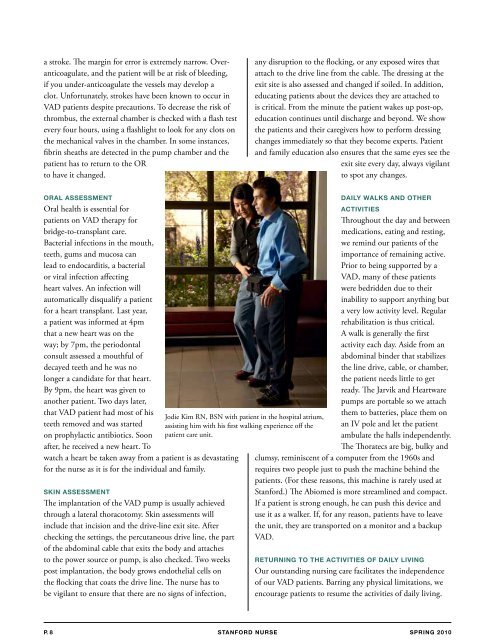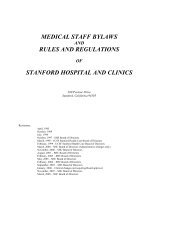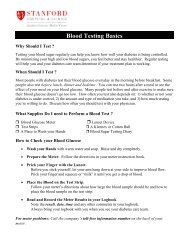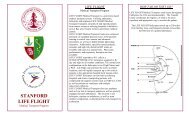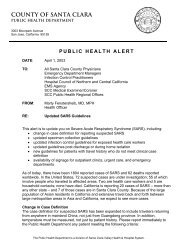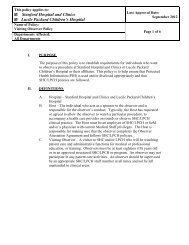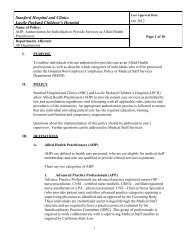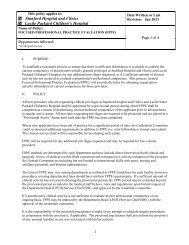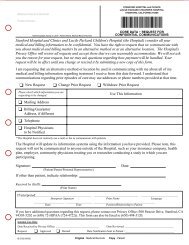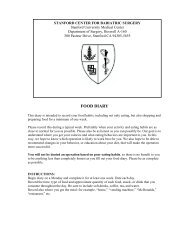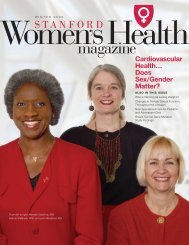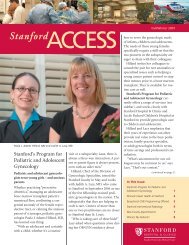SpRiNG 2010 - Stanford Hospital & Clinics
SpRiNG 2010 - Stanford Hospital & Clinics
SpRiNG 2010 - Stanford Hospital & Clinics
You also want an ePaper? Increase the reach of your titles
YUMPU automatically turns print PDFs into web optimized ePapers that Google loves.
a stroke. The margin for error is extremely narrow. Overanticoagulate,<br />
and the patient will be at risk of bleeding,<br />
if you under-anticoagulate the vessels may develop a<br />
clot. Unfortunately, strokes have been known to occur in<br />
VAD patients despite precautions. To decrease the risk of<br />
thrombus, the external chamber is checked with a flash test<br />
every four hours, using a flashlight to look for any clots on<br />
the mechanical valves in the chamber. In some instances,<br />
fibrin sheaths are detected in the pump chamber and the<br />
patient has to return to the OR<br />
to have it changed.<br />
ORAl ASSESSMENT<br />
Oral health is essential for<br />
patients on VAD therapy for<br />
bridge-to-transplant care.<br />
Bacterial infections in the mouth,<br />
teeth, gums and mucosa can<br />
lead to endocarditis, a bacterial<br />
or viral infection affecting<br />
heart valves. An infection will<br />
automatically disqualify a patient<br />
for a heart transplant. Last year,<br />
a patient was informed at 4pm<br />
that a new heart was on the<br />
way; by 7pm, the periodontal<br />
consult assessed a mouthful of<br />
decayed teeth and he was no<br />
longer a candidate for that heart.<br />
By 9pm, the heart was given to<br />
another patient. Two days later,<br />
that VAD patient had most of his<br />
teeth removed and was started<br />
on prophylactic antibiotics. Soon<br />
after, he received a new heart. To<br />
watch a heart be taken away from a patient is as devastating<br />
for the nurse as it is for the individual and family.<br />
SkiN ASSESSMENT<br />
The implantation of the VAD pump is usually achieved<br />
through a lateral thoracotomy. Skin assessments will<br />
include that incision and the drive-line exit site. After<br />
checking the settings, the percutaneous drive line, the part<br />
of the abdominal cable that exits the body and attaches<br />
to the power source or pump, is also checked. Two weeks<br />
post implantation, the body grows endothelial cells on<br />
the flocking that coats the drive line. The nurse has to<br />
be vigilant to ensure that there are no signs of infection,<br />
Jodie Kim RN, BSN with patient in the hospital atrium,<br />
assisting him with his first walking experience off the<br />
patient care unit.<br />
any disruption to the flocking, or any exposed wires that<br />
attach to the drive line from the cable. The dressing at the<br />
exit site is also assessed and changed if soiled. In addition,<br />
educating patients about the devices they are attached to<br />
is critical. From the minute the patient wakes up post-op,<br />
education continues until discharge and beyond. We show<br />
the patients and their caregivers how to perform dressing<br />
changes immediately so that they become experts. Patient<br />
and family education also ensures that the same eyes see the<br />
exit site every day, always vigilant<br />
to spot any changes.<br />
DAily WAlkS AND OThER<br />
AcTiviTiES<br />
Throughout the day and between<br />
medications, eating and resting,<br />
we remind our patients of the<br />
importance of remaining active.<br />
Prior to being supported by a<br />
VAD, many of these patients<br />
were bedridden due to their<br />
inability to support anything but<br />
a very low activity level. Regular<br />
rehabilitation is thus critical.<br />
A walk is generally the first<br />
activity each day. Aside from an<br />
abdominal binder that stabilizes<br />
the line drive, cable, or chamber,<br />
the patient needs little to get<br />
ready. The Jarvik and Heartware<br />
pumps are portable so we attach<br />
them to batteries, place them on<br />
an IV pole and let the patient<br />
ambulate the halls independently.<br />
The Thoratecs are big, bulky and<br />
clumsy, reminiscent of a computer from the 1960s and<br />
requires two people just to push the machine behind the<br />
patients. (For these reasons, this machine is rarely used at<br />
<strong>Stanford</strong>.) The Abiomed is more streamlined and compact.<br />
If a patient is strong enough, he can push this device and<br />
use it as a walker. If, for any reason, patients have to leave<br />
the unit, they are transported on a monitor and a backup<br />
VAD.<br />
RETURNiNG TO ThE AcTiviTiES OF DAily liviNG<br />
Our outstanding nursing care facilitates the independence<br />
of our VAD patients. Barring any physical limitations, we<br />
encourage patients to resume the activities of daily living.<br />
p. 8 STANFORD NURSE<br />
<strong>SpRiNG</strong> <strong>2010</strong>


